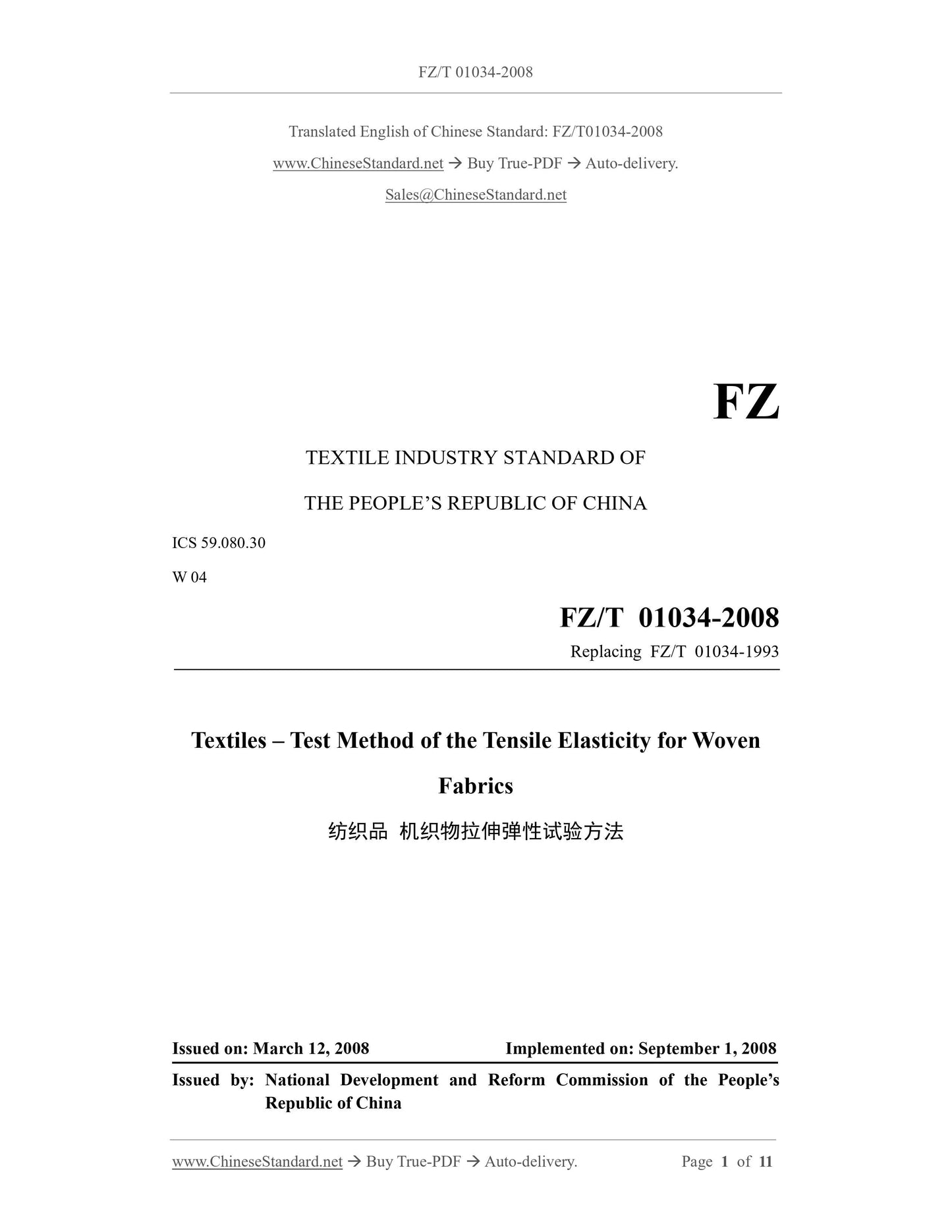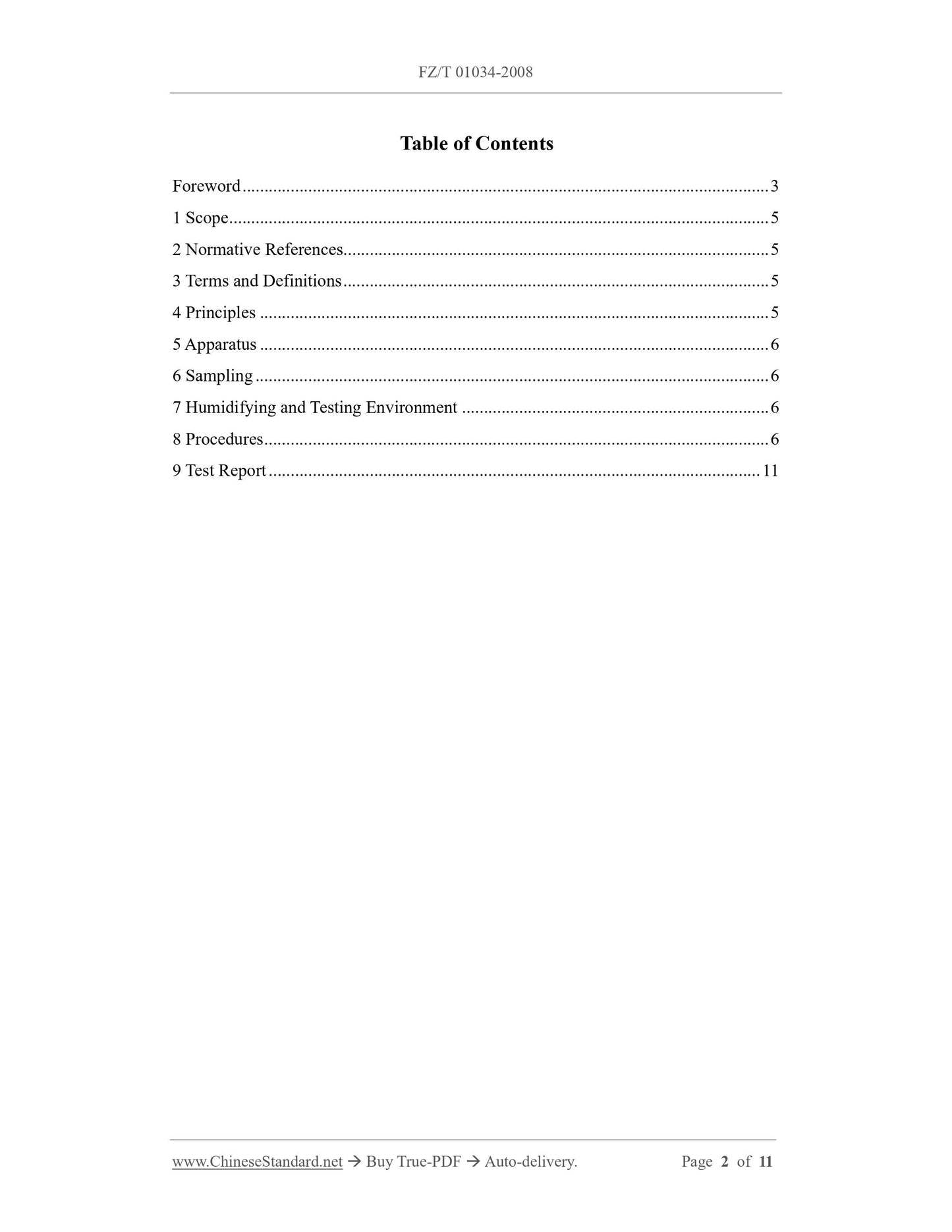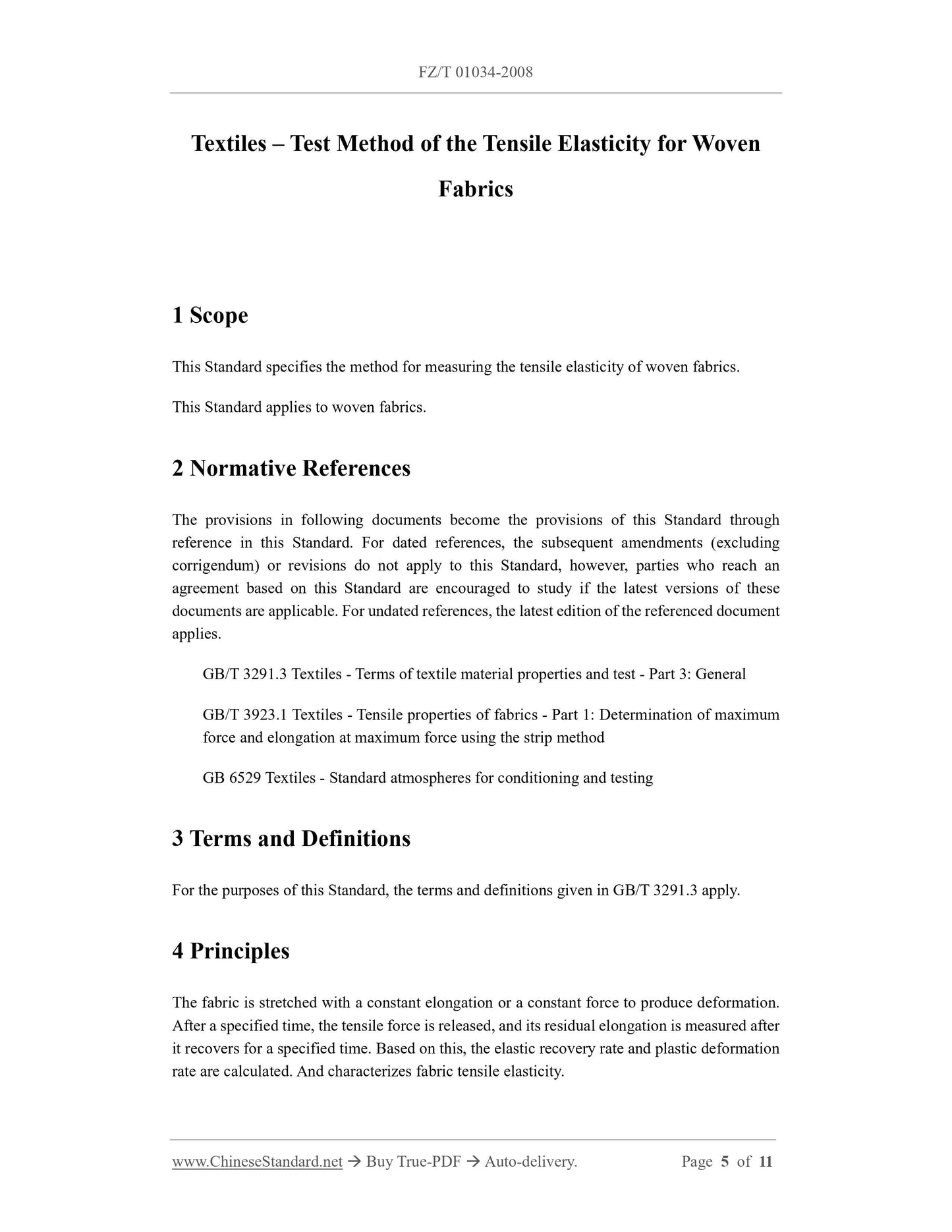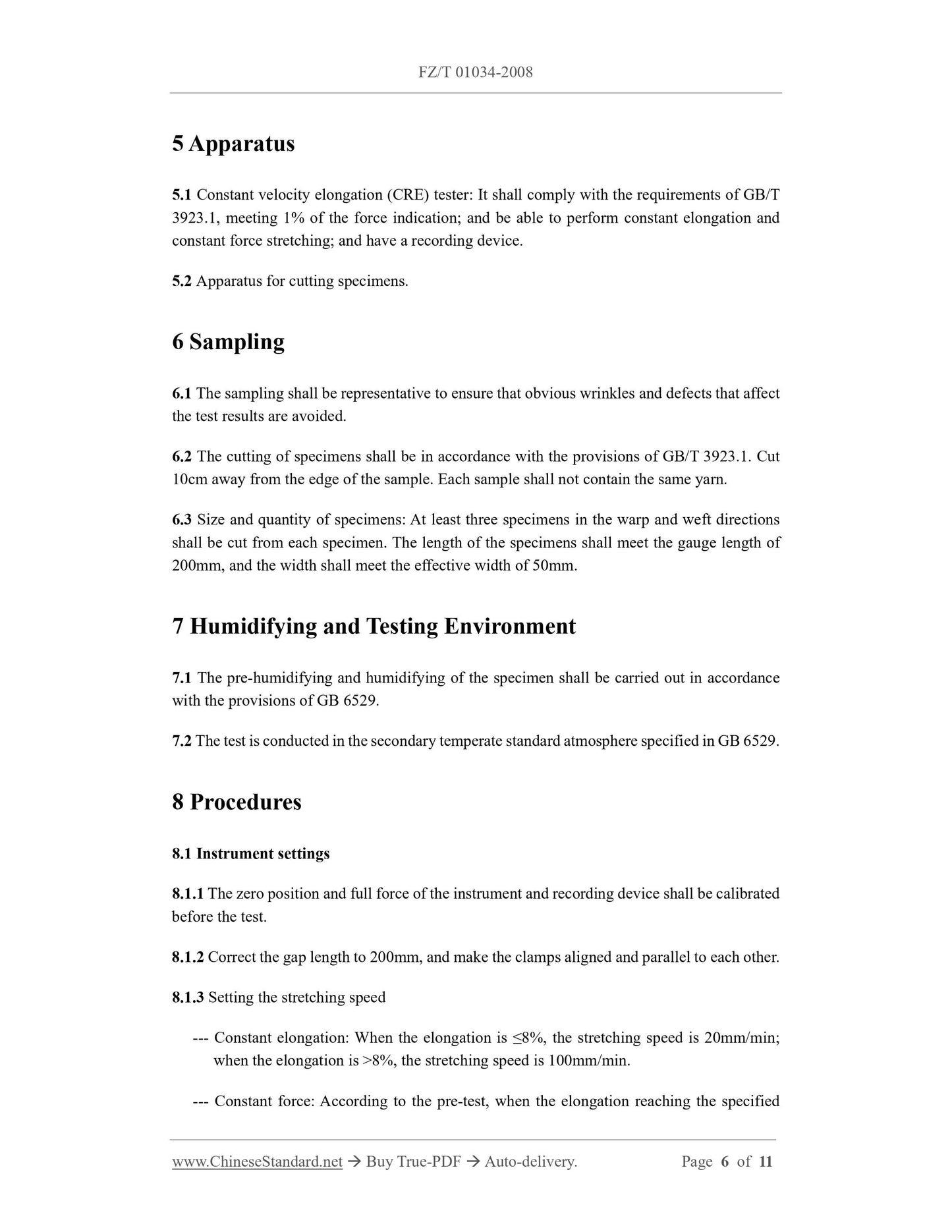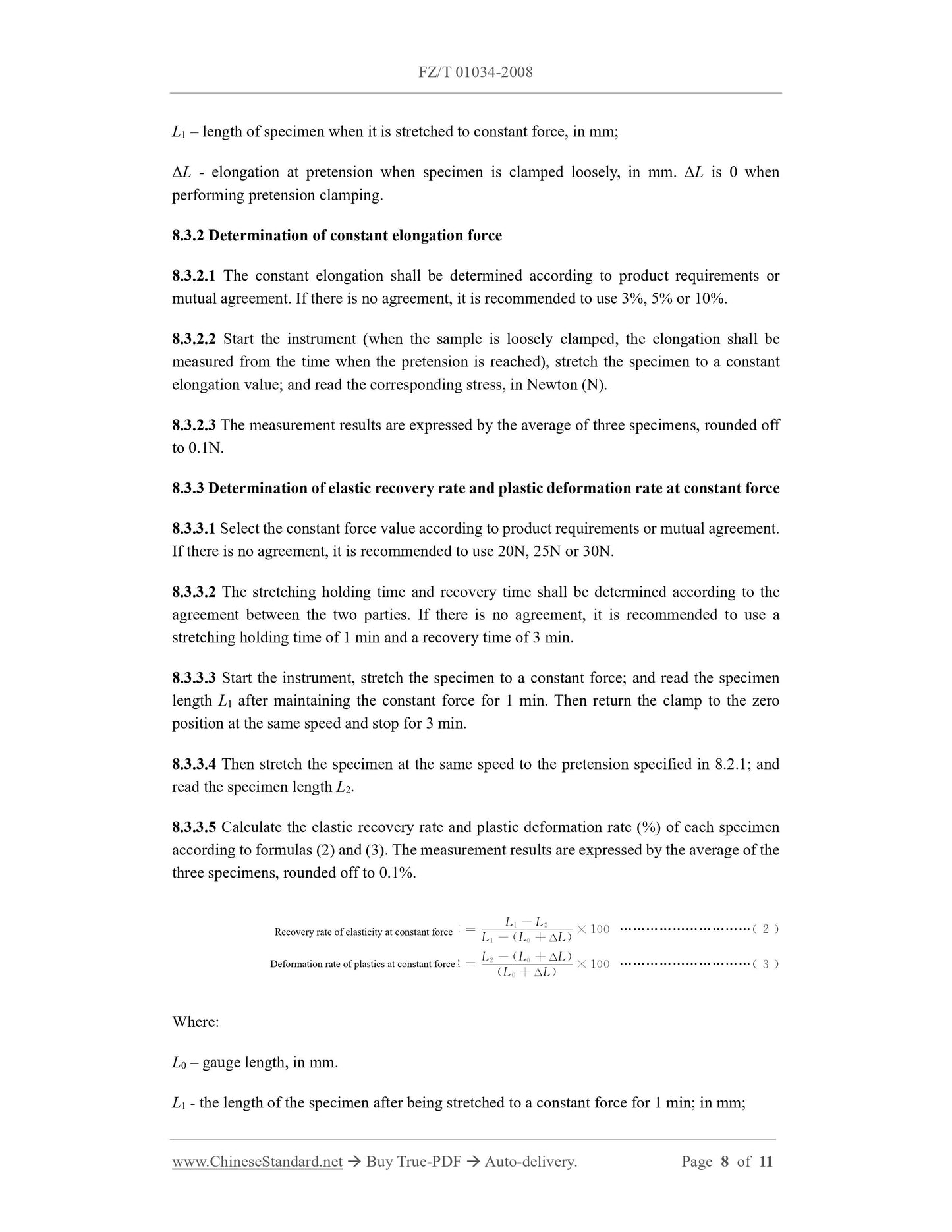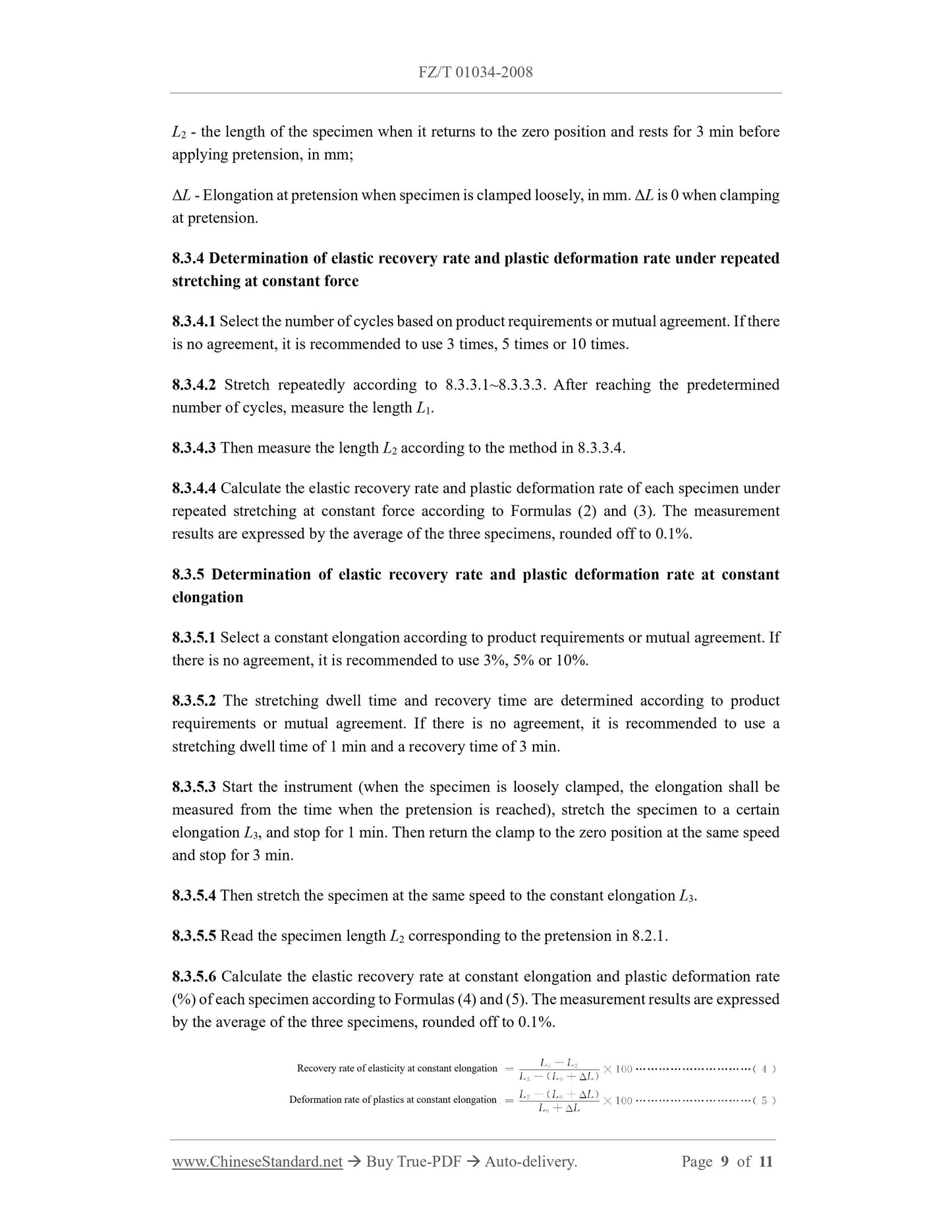PayPal, credit cards. Download editable-PDF and invoice in 1 second!
FZ/T 01034-2008 English PDF (FZT01034-2008)
FZ/T 01034-2008 English PDF (FZT01034-2008)
Precio habitual
$95.00 USD
Precio habitual
Precio de oferta
$95.00 USD
Precio unitario
/
por
Los gastos de envío se calculan en la pantalla de pago.
No se pudo cargar la disponibilidad de retiro
Delivery: 3 seconds. Download true-PDF + Invoice.
Get QUOTATION in 1-minute: Click FZ/T 01034-2008
Historical versions: FZ/T 01034-2008
Preview True-PDF (Reload/Scroll if blank)
FZ/T 01034-2008: Textiles. Test methods of the tensile elasticity for woven fabrics
FZ/T 01034-2008
FZ
TEXTILE INDUSTRY STANDARD OF
THE PEOPLE’S REPUBLIC OF CHINA
ICS 59.080.30
W 04
Replacing FZ/T 01034-1993
Textiles – Test Method of the Tensile Elasticity for Woven
Fabrics
ISSUED ON: MARCH 12, 2008
IMPLEMENTED ON: SEPTEMBER 1, 2008
Issued by: National Development and Reform Commission of the People’s
Republic of China
Table of Contents
Foreword ... 3
1 Scope ... 5
2 Normative References ... 5
3 Terms and Definitions ... 5
4 Principles ... 5
5 Apparatus ... 6
6 Sampling ... 6
7 Humidifying and Testing Environment ... 6
8 Procedures ... 6
9 Test Report ... 11
Textiles – Test Method of the Tensile Elasticity for Woven
Fabrics
1 Scope
This Standard specifies the method for measuring the tensile elasticity of woven fabrics.
This Standard applies to woven fabrics.
2 Normative References
The provisions in following documents become the provisions of this Standard through
reference in this Standard. For dated references, the subsequent amendments (excluding
corrigendum) or revisions do not apply to this Standard, however, parties who reach an
agreement based on this Standard are encouraged to study if the latest versions of these
documents are applicable. For undated references, the latest edition of the referenced document
applies.
GB/T 3291.3 Textiles - Terms of textile material properties and test - Part 3: General
GB/T 3923.1 Textiles - Tensile properties of fabrics - Part 1: Determination of maximum
force and elongation at maximum force using the strip method
GB 6529 Textiles - Standard atmospheres for conditioning and testing
3 Terms and Definitions
For the purposes of this Standard, the terms and definitions given in GB/T 3291.3 apply.
4 Principles
The fabric is stretched with a constant elongation or a constant force to produce deformation.
After a specified time, the tensile force is released, and its residual elongation is measured after
it recovers for a specified time. Based on this, the elastic recovery rate and plastic deformation
rate are calculated. And characterizes fabric tensile elasticity.
5 Apparatus
5.1 Constant velocity elongation (CRE) tester: It shall comply with the requirements of GB/T
3923.1, meeting 1% of the force indication; and be able to perform constant elongation and
constant force stretching; and have a recording device.
5.2 Apparatus for cutting specimens.
6 Sampling
6.1 The sampling shall be representative to ensure that obvious wrinkles and defects that affect
the test results are avoided.
6.2 The cutting of specimens shall be in accordance with the provisions of GB/T 3923.1. Cut
10cm away from the edge of the sample. Each sample shall not contain the same yarn.
6.3 Size and quantity of specimens: At least three specimens in the warp and weft directions
shall be cut from each specimen. The length of the specimens shall meet the gauge length of
200mm, and the width shall meet the effective width of 50mm.
7 Humidifying and Testing Environment
7.1 The pre-humidifying and humidifying of the specimen shall be carried out in accordance
with the provisions of GB 6529.
7.2 The test is conducted in the secondary temperate standard atmosphere specified in GB 6529.
8 Procedures
8.1 Instrument settings
8.1.1 The zero position and full force of the instrument and recording device shall be calibrated
before the test.
8.1.2 Correct the gap length to 200mm, and make the clamps aligned and parallel to each other.
8.1.3 Setting the stretching speed
--- Constant elongation: When the elongation is ≤8%, the stretching speed is 20mm/min;
when the elongation is >8%, the stretching speed is 100mm/min.
--- Constant force: According to the pre-test, when the elongation reaching the specified
L1 – length of specimen when it is stretched to constant force, in mm;
ΔL - elongation at pretension when specimen is clamped loosely, in mm. ΔL is 0 when
performing pretension clamping.
8.3.2 Determination of constant elongation force
8.3.2.1 The constant elongation shall be determined according to product requirements or
mutual agreement. If there is no agreement, it is recommended to use 3%, 5% or 10%.
8.3.2.2 Start the instrument (when the sample is loosely clamped, the elongation shall be
measured from the time when the pretension is reached), stretch the specimen to a constant
elongation value; and read the corresponding stress, in Newton (N).
8.3.2.3 The measurement results are expressed by the average of three specimens, rounded off
to 0.1N.
8.3.3 Determination of elastic recovery rate and plastic deformation rate at constant force
8.3.3.1 Select the constant force value according to product requirements or mutual agreement.
If there is no agreement, it is recommended to use 20N, 25N or 30N.
8.3.3.2 The stretching holding time and recovery time shall be determined according to the
agreement between the two parties. If there is no agreement, it is recommended to use a
stretching holding time of 1 min and a recovery time of 3 min.
8.3.3.3 Start the instrument, stretch the specimen to a constant force; and read the specimen
length L1 after maintaining the constant force for 1 min. Then return the clamp to the zero
position at the same speed and stop for 3 min.
8.3.3.4 Then stretch the specimen at the same speed to the pretension specified in 8.2.1; and
read the specimen length L2.
8.3.3.5 Calculate the elastic recovery rate and plastic deformation rate (%) of each specimen
according to formulas (2) and (3). The measurement results are expressed by the average of the
three specimens, rounded off to 0.1%.
Where:
L0 – gauge length, in mm.
L1 - the length of the specimen after being stretched to a constant force for 1 min; in mm;
Recovery rate of elasticity at constant force
Deformation rate of plastics at constant force
L2 - the length of the specimen when it returns to the zero position and rests for 3 min before
applying pretension, in mm;
ΔL - Elongation at pretension when specimen is clamped loosely, in mm. ΔL is 0 when clamping
at pretension.
8.3.4 Determination of elastic recovery rate and plastic deformation rate under repeated
stretching at constant force
8.3.4.1 Select the number of cycles based on product requirements or mutual agreement. If there
is no agreement, it is recommended to use 3 times, 5 times or 10 times.
8.3.4.2 Stretch repeatedly according to 8.3.3.1~8.3.3.3. After reaching the predetermined
number of cycles, measure the length L1.
8.3.4.3 Then measure the length L2 according to the method in 8.3.3.4.
8.3.4.4 Calculate the elastic recovery rate and plastic deformation rate of each specimen under
repeated stretching at constant force according to Formulas (2) and (3). The measurement
results are expressed by the average of the three specimens, rounded off to 0.1%.
8.3.5 Determination of elastic recovery rate and plastic deformation rate at constant
elongation
8.3.5.1 Select a constant elongation according to product requirements or mutual agreement. If
there is no agreement, it is recommended to use 3%, 5% or 10%.
8.3.5.2 The stretching dwell time and recovery time are determined according to product
requirements or mutual agreement. If there is no agreement, it is recommended to use a
stretching dwell time of 1 min and a recovery time of 3 min.
8.3.5.3 Start the instrument (when the specimen is loosely clamped, the elongation shall be
measured from the time when the pretension is reached), stretch ...
Get QUOTATION in 1-minute: Click FZ/T 01034-2008
Historical versions: FZ/T 01034-2008
Preview True-PDF (Reload/Scroll if blank)
FZ/T 01034-2008: Textiles. Test methods of the tensile elasticity for woven fabrics
FZ/T 01034-2008
FZ
TEXTILE INDUSTRY STANDARD OF
THE PEOPLE’S REPUBLIC OF CHINA
ICS 59.080.30
W 04
Replacing FZ/T 01034-1993
Textiles – Test Method of the Tensile Elasticity for Woven
Fabrics
ISSUED ON: MARCH 12, 2008
IMPLEMENTED ON: SEPTEMBER 1, 2008
Issued by: National Development and Reform Commission of the People’s
Republic of China
Table of Contents
Foreword ... 3
1 Scope ... 5
2 Normative References ... 5
3 Terms and Definitions ... 5
4 Principles ... 5
5 Apparatus ... 6
6 Sampling ... 6
7 Humidifying and Testing Environment ... 6
8 Procedures ... 6
9 Test Report ... 11
Textiles – Test Method of the Tensile Elasticity for Woven
Fabrics
1 Scope
This Standard specifies the method for measuring the tensile elasticity of woven fabrics.
This Standard applies to woven fabrics.
2 Normative References
The provisions in following documents become the provisions of this Standard through
reference in this Standard. For dated references, the subsequent amendments (excluding
corrigendum) or revisions do not apply to this Standard, however, parties who reach an
agreement based on this Standard are encouraged to study if the latest versions of these
documents are applicable. For undated references, the latest edition of the referenced document
applies.
GB/T 3291.3 Textiles - Terms of textile material properties and test - Part 3: General
GB/T 3923.1 Textiles - Tensile properties of fabrics - Part 1: Determination of maximum
force and elongation at maximum force using the strip method
GB 6529 Textiles - Standard atmospheres for conditioning and testing
3 Terms and Definitions
For the purposes of this Standard, the terms and definitions given in GB/T 3291.3 apply.
4 Principles
The fabric is stretched with a constant elongation or a constant force to produce deformation.
After a specified time, the tensile force is released, and its residual elongation is measured after
it recovers for a specified time. Based on this, the elastic recovery rate and plastic deformation
rate are calculated. And characterizes fabric tensile elasticity.
5 Apparatus
5.1 Constant velocity elongation (CRE) tester: It shall comply with the requirements of GB/T
3923.1, meeting 1% of the force indication; and be able to perform constant elongation and
constant force stretching; and have a recording device.
5.2 Apparatus for cutting specimens.
6 Sampling
6.1 The sampling shall be representative to ensure that obvious wrinkles and defects that affect
the test results are avoided.
6.2 The cutting of specimens shall be in accordance with the provisions of GB/T 3923.1. Cut
10cm away from the edge of the sample. Each sample shall not contain the same yarn.
6.3 Size and quantity of specimens: At least three specimens in the warp and weft directions
shall be cut from each specimen. The length of the specimens shall meet the gauge length of
200mm, and the width shall meet the effective width of 50mm.
7 Humidifying and Testing Environment
7.1 The pre-humidifying and humidifying of the specimen shall be carried out in accordance
with the provisions of GB 6529.
7.2 The test is conducted in the secondary temperate standard atmosphere specified in GB 6529.
8 Procedures
8.1 Instrument settings
8.1.1 The zero position and full force of the instrument and recording device shall be calibrated
before the test.
8.1.2 Correct the gap length to 200mm, and make the clamps aligned and parallel to each other.
8.1.3 Setting the stretching speed
--- Constant elongation: When the elongation is ≤8%, the stretching speed is 20mm/min;
when the elongation is >8%, the stretching speed is 100mm/min.
--- Constant force: According to the pre-test, when the elongation reaching the specified
L1 – length of specimen when it is stretched to constant force, in mm;
ΔL - elongation at pretension when specimen is clamped loosely, in mm. ΔL is 0 when
performing pretension clamping.
8.3.2 Determination of constant elongation force
8.3.2.1 The constant elongation shall be determined according to product requirements or
mutual agreement. If there is no agreement, it is recommended to use 3%, 5% or 10%.
8.3.2.2 Start the instrument (when the sample is loosely clamped, the elongation shall be
measured from the time when the pretension is reached), stretch the specimen to a constant
elongation value; and read the corresponding stress, in Newton (N).
8.3.2.3 The measurement results are expressed by the average of three specimens, rounded off
to 0.1N.
8.3.3 Determination of elastic recovery rate and plastic deformation rate at constant force
8.3.3.1 Select the constant force value according to product requirements or mutual agreement.
If there is no agreement, it is recommended to use 20N, 25N or 30N.
8.3.3.2 The stretching holding time and recovery time shall be determined according to the
agreement between the two parties. If there is no agreement, it is recommended to use a
stretching holding time of 1 min and a recovery time of 3 min.
8.3.3.3 Start the instrument, stretch the specimen to a constant force; and read the specimen
length L1 after maintaining the constant force for 1 min. Then return the clamp to the zero
position at the same speed and stop for 3 min.
8.3.3.4 Then stretch the specimen at the same speed to the pretension specified in 8.2.1; and
read the specimen length L2.
8.3.3.5 Calculate the elastic recovery rate and plastic deformation rate (%) of each specimen
according to formulas (2) and (3). The measurement results are expressed by the average of the
three specimens, rounded off to 0.1%.
Where:
L0 – gauge length, in mm.
L1 - the length of the specimen after being stretched to a constant force for 1 min; in mm;
Recovery rate of elasticity at constant force
Deformation rate of plastics at constant force
L2 - the length of the specimen when it returns to the zero position and rests for 3 min before
applying pretension, in mm;
ΔL - Elongation at pretension when specimen is clamped loosely, in mm. ΔL is 0 when clamping
at pretension.
8.3.4 Determination of elastic recovery rate and plastic deformation rate under repeated
stretching at constant force
8.3.4.1 Select the number of cycles based on product requirements or mutual agreement. If there
is no agreement, it is recommended to use 3 times, 5 times or 10 times.
8.3.4.2 Stretch repeatedly according to 8.3.3.1~8.3.3.3. After reaching the predetermined
number of cycles, measure the length L1.
8.3.4.3 Then measure the length L2 according to the method in 8.3.3.4.
8.3.4.4 Calculate the elastic recovery rate and plastic deformation rate of each specimen under
repeated stretching at constant force according to Formulas (2) and (3). The measurement
results are expressed by the average of the three specimens, rounded off to 0.1%.
8.3.5 Determination of elastic recovery rate and plastic deformation rate at constant
elongation
8.3.5.1 Select a constant elongation according to product requirements or mutual agreement. If
there is no agreement, it is recommended to use 3%, 5% or 10%.
8.3.5.2 The stretching dwell time and recovery time are determined according to product
requirements or mutual agreement. If there is no agreement, it is recommended to use a
stretching dwell time of 1 min and a recovery time of 3 min.
8.3.5.3 Start the instrument (when the specimen is loosely clamped, the elongation shall be
measured from the time when the pretension is reached), stretch ...
Share
